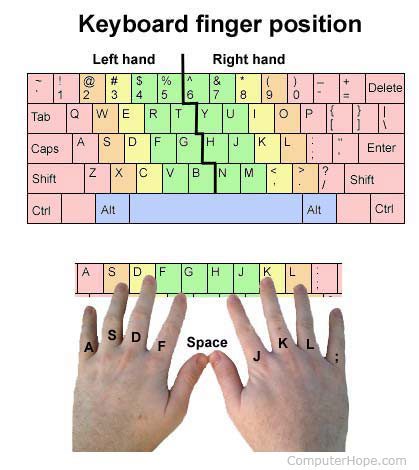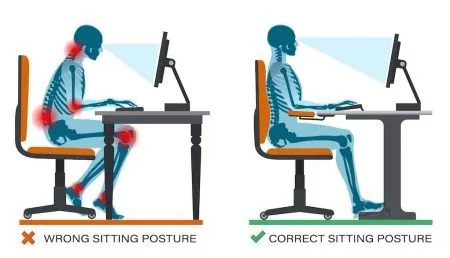It's hard to imagine a world without technology, especially since we tend to rely so much on it each and every day. Computers have taken over quite a large portion of our lives, helping us to complete daily tasks, socialize, study and even shop. In fact, we would probably find it quite difficult to get through the day without needing, or wanting, to use technology.
That said, though, whilst the younger generation has grown up with technology (literally) at their fingertips, some of those in the older generation may not be quite as comfortable with using it. In actual fact, there are many who find computers to be quite challenging to navigate.
One of the main challenges being faced is that of typing. Typing is technological communication and there are so many benefits of mastering the art of what is called "touch typing."
Touch typing is the art of being able to type whilst not looking at the keyboard and having your fingers placed on specific keys. Being able to master touch typing will not only improve your typing experience but it will also give you the ability to type faster with higher accuracy.
Added to this, touch typing also improves brain function because it utilizes muscle memory and also engages motor and sensory faculties as well. So while you are busy practicing your typing, you're also exercising your brain and keeping it fit. Typing activates both sides of your brain and gives your brain a full workout -- without you really being aware of it.
We've put together seven tips for you in order to help you to improve your typing skills and make your typing experiences positive ones.
1. Get Acquainted With Your Keyboard
Firstly, you need to get acquainted with your keyboard and the correct way to place your fingers on the keys. This is extremely important because it will determine the speed and accuracy with which you type. Touch typing requires you to place your fingers in a specific way on the keyboard.

Your left hand fingers should rest on the A, S, D and F keys, with your thumb on the spacebar and then your right hand fingers should rest on the J, K, L and the semi-colon keys and your right-hand thumb also on the spacebar. These keys are called the "home keys".
By using this method of touch typing, you will greatly improve your typing speed and also the accuracy with which you type.
2. Use the Online Typing Resources at Your Disposal
Perhaps you're one of the many who think that a person is either a good typist or a "hunt and peck" typist -- employing the method of staring at the keyboard and "pecking" out the letters with two fingers.
In reality, though, there are many ways that can help you to improve your typing ability. One of these ways is to use an online resource, such as an online tutorial on how to touch type.
There are also many apps or even games that you can download which will help you to have fun whilst practicing typing. For example, KeyBlaze Typing Tutor is a useful program that helps you to improve your typing ability; you are able to set typing goals and will even receive a certificate upon achieving those goals.
This program is available for Windows as well as MacOS. However, the free version is limited in what it offers. Typing.com is another program that has great lessons and will highlight your problem areas and track your typing progress.
Want to take a break from your strenuous practicing session and play a game? How about taking on a game of Typing Invaders, which is a fun game that requires you to type the correct words and sequences in order to shoot through the aliens that are after you. It's a great way to practice your typing speed and accuracy without actually being aware that you are practicing.
3. Speed vs. Accuracy
Being able to type faster is awesome, except when it takes precedence over accuracy. There is no point in typing fast if you aren't typing accurately. One of the benefits of touch typing is that it improves your speed, but if it is done correctly from the beginning, then it will also improve your accuracy.
When you mistype a word, instead of relying on your spell checker to correct it (or correcting it later), you need to erase the entire word and retype it correctly. In the beginning this will take time and it may even be frustrating, but it is very important as your brain relies on muscle memory and so when you completely delete a word and retype it, your brain will remember it and the next time you will type the word correctly.
4. Proper Posture Leads to Perfection
While some people might mock the idea of posture having anything to do with typing (especially since the norm seems to be hunching over a keyboard), having the correct posture certainly does improve your typing experience and helps to better not only speed but also accuracy.

According to Cornell University (no, not that one), correct posturing is key and the correct posture is such that your keyboard is below your elbow height when you are seated, your wrists need to be straight and not planted on your desk and the top of your screen needs to be at eye level. You also need to make sure that both your feet are flat on the ground and that your back and neck are straight.
By using the correct posturing you will also decrease the likelihood of developing carpal tunnel syndrome or other repetitive strain injuries.
5. Don't Look at the Keyboard
This might sound counter-productive but it's actually a really valid point. When musicians play, they will look at the music they are playing and not at their instrument.
In the same way, when you are touch typing, you need to be so in tune with your keyboard and where your fingers are placed that you don't need to look at the keyboard in order to see where the letters are that you need to type.
This, in turn, brings a certain rhythm to your typing - almost like making typing music. Once your fingers are properly placed and you have familiarized yourself with the keyboard, you will find that, in time, your fingers will remember where everything is and you will be able to type more effortlessly.
It is important to begin right, though, and make sure that right from the start you are training your brain and fingers correctly. This means that you should not be looking at the keyboard, even when you are first learning the touch typing method.
If you struggle with this, try placing a light cloth or a piece of paper over your hands as they rest on the keyboard. Then, when you start typing, you won't be able to see the keys and will need to find them from memory.
6. Employ the Help of Voice-to-Text
Facing the reality of aging can be difficult - but when it comes to typing, it doesn't have to be. Some people need a little help now and then, and Google has just the help you might need in their Google Keyboard program. Whilst this program was initially designed as a keyboard for physical input, it has a voice option which allows you to turn voice into text.
Microsoft Dictate is another free tool which can be used and allows you to type with your voice, giving your fingers and wrists some well needed and well deserved rest.
By using one of these programs, you have the opportunity to save some time by using a voice to text application that takes everything you say and puts it into type-written script. Then all you will need to do is give it the once over to make sure it is accurate and all is correct. While this doesn't improve your typing skills, it is a way to employ help where it is needed if you are limited in any way.
7. Remember the Importance of Rest
One thing that so many people forget about when it comes to typing and improving on typing ability is the need for proper rest. Our bodies are not machines; they do need adequate and regular rest in order to function at their optimum level. Getting the right amount of sleep and taking regular breaks when sitting in front of a screen are crucial.
Employing the 20-20-20 rule is a good start. Every twenty minutes, look away from your screen for twenty seconds at something that is twenty feet away. This gives your eyes a break and will help to prevent eye strain.
Another good rule of thumb is to stand up and stretch every hour or so, or sooner if you feel your back and neck are getting a bit stiff. Studies show that taking regular breaks will improve your brain function and will also lead to greater productivity.
There are many advantages to being able to touch type, not least of which is efficiency and accuracy. You'll get so much more done in a much shorter space of time, which then frees you up to spend time on other activities.
Proper typing habits also prevent both physical and mental fatigue. Added to this, being able to learn this new skill will help to keep your brain young and energetic - something that is definitely beneficial to all of us, no matter our age.
As always, if you're needing any kind of additional help with your typing, consider reaching out to HelpCloud technicians for remote support.

